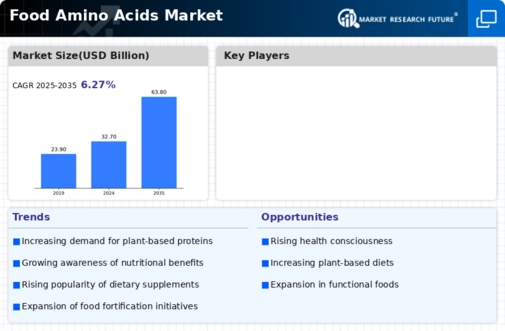Top Industry Leaders in the Food Amino Acids Market

The Food Amino Acids Market is a crucial segment within the global food and beverage industry, playing a vital role in enhancing the nutritional profile and flavor of various food products. This analysis provides insights into the competitive dynamics of the Food Amino Acids Market, encompassing key players, their strategies, market share determinants, emerging entities, industry news, current investment trends, and the overall competitive scenario in 2023.
Key Players:
Ajinomoto Co. Inc.
Kyowa Hakko Kirin Group
Evonik Industries AG
Sigma-Aldrich Corporation
Prinova Corporation
Daesang Corporation
Qingdao Samin Chemical Co. Ltd.
Hugestone Enterprise Co. Ltd.
Strategies Adopted:
Strategies adopted by key players in the Food Amino Acids Market encompass a range of approaches aimed at product innovation, market expansion, strategic partnerships, and compliance with regulatory standards.
Product innovation is a central strategy for key players in this market. Continuous efforts are made to develop new amino acid formulations that cater to evolving consumer preferences for healthier and more sustainable food options. This often involves research and development initiatives to identify novel sources and extraction methods.
Market expansion is pursued through geographical diversification and tapping into new application areas. Key players seek to enter emerging markets and collaborate with food manufacturers to incorporate amino acids into a broader range of products, expanding their market presence.
Strategic partnerships and collaborations are common in the food amino acids sector. Companies often form alliances with food manufacturers, research institutions, and other industry stakeholders to leverage complementary expertise, enhance production capabilities, and explore new avenues for product development.
Compliance with regulatory standards is a fundamental aspect of the strategies adopted by key players. Given the importance of amino acids in the food industry, companies prioritize adherence to safety and quality standards set by regulatory bodies to ensure consumer trust and maintain market credibility.
Market Share Analysis:
Market share analysis in the Food Amino Acids Market is influenced by various factors, including product quality, regulatory compliance, supply chain efficiency, and customer relationships. Companies that consistently deliver high-quality amino acid products, adhering to safety and regulatory standards, are more likely to gain and retain a significant market share.
Efficient supply chains play a crucial role in market share analysis. Companies with streamlined and reliable distribution networks can ensure that their amino acid products are readily available to consumers, contributing to increased market share.
Customer relationships are pivotal for market share, with companies that actively engage with customers, address their concerns, and provide transparent information about their amino acid products fostering trust and loyalty. This is particularly important in a market where consumer preferences are increasingly focused on transparency and authenticity.
News & Emerging Companies:
News within the Food Amino Acids Market often revolves around technological advancements in amino acid production, sustainability initiatives, and the introduction of innovative amino acid formulations. Emerging companies in this sector frequently focus on leveraging biotechnological processes and sustainable sourcing to differentiate their amino acid products.
Industry news also highlights the incorporation of amino acids into plant-based food products, responding to the growing demand for protein-rich options in the plant-based food sector. This reflects the adaptability of amino acids to various food applications and their alignment with current consumer trends.
Industry Trends:
Investment trends in the Food Amino Acids Market center around technology-driven production methods, sustainability practices, and capacity expansion. Companies invest in research and development to enhance fermentation processes, allowing for more efficient and cost-effective amino acid production.
Sustainability practices are increasingly prioritized, with companies investing in eco-friendly sourcing, waste reduction, and energy-efficient manufacturing processes. Investments in sustainable practices not only align with consumer preferences but also contribute to long-term market viability.
Capacity expansion remains a key investment trend, ensuring that companies can meet the growing demand for amino acids. This often involves the construction of new production facilities, upgrading existing ones, and optimizing manufacturing processes to enhance efficiency.
Competitive Scenario:
The Food Amino Acids Market exhibits a competitive landscape where key players balance innovation, sustainability, and compliance to maintain market leadership. Established companies leverage their global presence, extensive distribution networks, and research capabilities to stay ahead, while emerging players contribute to market diversity and technological advancements.
Competitiveness is also influenced by factors such as cost-effectiveness, scalability, and the ability to cater to diverse customer needs. Companies that successfully navigate these factors are well-positioned to thrive in the dynamic Food Amino Acids Market.
Recent Development
The Food Amino Acids Market was the increased emphasis on sustainable sourcing. Key players, in response to consumer demand for ethically and sustainably produced food ingredients, made significant investments in sourcing amino acids from environmentally responsible and traceable supply chains. This development underscores the industry's commitment to environmental stewardship and aligns with broader sustainability trends in the food sector.


